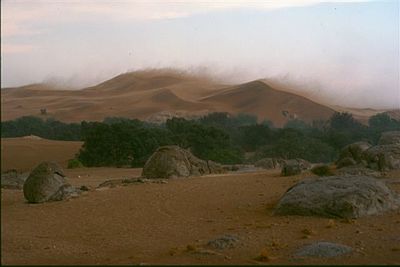Wedged between ibises, ducks, geese and swans, the decurved-beaked flamingo is among the most highly specialized filter feeders in the bird world. In the capricious climate that it inhabits, this specialist faces ever-mounting pressures to survive.
In ornithological parlance the flamingo family of Phoenicopteridae (meaning ‘crimson-winged’) are among the earliest bird groups that are still alive today. Their evolution is rooted in the times when reptiles developed feathers instead of scales and Archaeopterix rose phoenix-like from the morasses of the Triassic era. Long, long ago, in a young world, survival in the marshes of steamy swamps meant possessing elongated legs to wade with and extended necks to feed from the rich nutrients that oozed off the bottom of tropical bogs. Fossil tracks in Utah, USA show a series of dot-like beak marks and webbed feet, made by a prototype flamingo, roughly 50 million years ago. Coming from a common ancestor of modern waterfowl, even a flamingo’s parasitic feather lice are remarkably similar to ducks. Its swimming ability, webbed toes and finely grooved beak for filtering small organisms from the water align flamingos closely with ducks and their double-syllabled honk-honk reinforces their goose relationship.
As the swamplands dried and were replaced by aridity, these flying relicts of an earlier, moister clime witnessed the shrinking of continental wetlands to remnant, shallow soda lakes and saline lagoons. Barren wildernesses and desert wastes surround their modern world. Consequently, we encounter three of the six surviving flamingo species distributed across the remoteness of the high Andes and Chilean plateaus at altitudes exceeding 4 000 metres. Here isolated populations of the little-known Andean, Chilean and rare James’ flamingo nest in extreme temperatures, on salt lakes that range from ice to hot thermal springs. Wind and snow-swept, these inhospitable highlands produce winter temperatures of minus 260C, rising to only 150C in mid-summer. The fourth New World flamingo is the Caribbean species, resplendent in its scarlet plumage, which inhabits the tropical humidity of Cuba, Haiti and other islands off the Gulf of Mexico.
The remaining two species paddle in the brine and alkaline waters of the Old World. Tall, regal Greater Flamingos fly between Asia and Europe, winging their way along marshes of the French Camargue, across the Mediterranean to Africa where they join their much smaller relative, the Lesser Flamingo. Inhabiting the blistering soda lakes of Natron and the equally inhospitable alkalinity of Nakuru in East Africa, some 50 000 Greater and 3 million Lesser Flamingos scoop up the rich broth that their waters provide. Feeding with upside-down bills, the decurved shape provides a perfect serving spoon. Lesser Flamingos are essentially herbivores that ‘graze’ microorganisms such as blue-green algae on the water surface. Thousands of minuscule brushes on the inner plane of its beak mesh momentarily when it is closed. Using its muscular tongue like a piston, the flamingo pumps a living soup through these filaments several times a second. Rich supplies of yellow, orange and red pigments, called carotenes, mingle in the frantically feeding bird to produce the crimson and pink colours that emerge on feathers, legs and beaks. Fundamentally carnivores, Greater Flamingos have a different bill with which to forage – coarse, tooth-like spikes project from the tongue and inner beak, creating an ideal instrument to strain small animals from the water. Rhythmic paddling, giving the impression of a circular dance, stirs up mud on the bottom. In this manner, tiny crustaceans, insect larvae and small snails are sucked up. Their carotene contents are deposited via the bloodstream onto feathers and skin, generating a dazzling flash of crimson that shows when Greater Flamingos extend their wings. This has significance for the pre-nuptial display, when this most highly social of birds begins its breeding cycle. The signal is given – flamingos bunch tightly together, necks raised, and begin flagging their heads sharply from side-to-side. As if in an hypnotic trance, the head-snapping progresses to a strutting march, which culminates in a spectacular ‘wing salute’ as thousands of birds stop and simultaneously stretch their wings outwards for several seconds. The result is spectacular – a flash of the deepest crimson contrasting sharply against black primary flight feathers. This prompted the author Laurence Green to title his renowned book about the Namib coast ‘On Wings of Fire’.
Thus stimulated, flamingo flocks depart the desert shore, responding to distant rain fronts that soak the desiccated Etosha Pan 500 km to the north-east or, failing that, 1 000 km eastwards to Makgadigadi Pans in Botswana. When sunset and nightly fog shroud the lagoons of Sandwich and Walvis Bay, long legs and long necks form flaming skeins as tens of thousands of flamingos ascend to fly unerringly through the darkness towards where the rain is falling. Maintaining a speed of 50 kilometres an hour they refer to the starlit sky for direction, keeping contact with each other by persistent, goose-like honking. Next morning early, before the Sun lights up Etosha, their calls can be heard as they descend onto the flooded surface of the giant Pan. How do these long distance travellers know when to trek inland? The rain is too far away to be smelled, too distant to see the lightning flashes, and too remote to hear thunder rumbling. One hypothesis is that a flamingo’s sense of pressure change is so delicate that the barometric drop foreshadowing significant rainfall is registered in its brain, acting as the primary cue to migrate.
Etosha’s parched surface floods, becoming an ephemeral, shallow lagoon. Sediments, salts and clay replace the ocean’s salinity, creating a vast feeding and nesting ground, remote and totally undisturbed. Decurved bills are put to another use – scooping up wet clay – a cup-shaped mound is created, drying quickly to accommodate a single egg. One month later thousands of hatching chicks begin calling to their parents, initiating a procedure called ‘voice imprinting’ whereby parents can recognize their own chick from a milling ‘kindergarten’ of young, in order to feed it. Flamingo food may be unique – a red fluid – secreted by the upper digestive tract, it is rich in fat and glucose but most surprisingly, it contains 1% whole blood. The physiological process this involves remains a mystery. The slushy diet is interspersed with sharp, broken fragments of eggshell as the rapidly growing chick seeks calcium to aid in bone development. Its stubby legs, measuring only a few centimeters, must grow up to half a metre in length within 10 weeks, when it fledges and becomes independent of parental care. Long legs are vital when the shallow waters surrounding nesting sites dry. Then the ‘kindergartens’ of flightless chicks must march towards the receding water, covering distances of up to 80 kilometres. That is where voice recognition between parents and chick is essential to provide nourishment for the long distance trekkers.
Longevity is also critical to the species survival because flamingos may breed only once in 10 years, under favourable conditions. Taking into account that over 50% of eggs and chicks don’t survive, it can require up to 25 years for one fledgling to emerge, and as much as 50 years before the parents have replaced themselves with two flying flamingos. A human generation takes 30 years, and the average world lifespan of people is now 66 years. We have technology that makes this possible. Flamingos don’t and they must live up to 70 years to ensure continued survival. Africa is dehydrating under the onslaught of falling aquifers and global climate change as humans continue to multiply and over-exploit the natural resources. Long legs, long neck, longevity and long distance traveling may not be sufficient to save Africa’s flamingos.
Text and photos by Hu Berry


